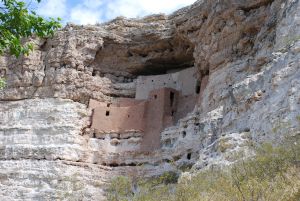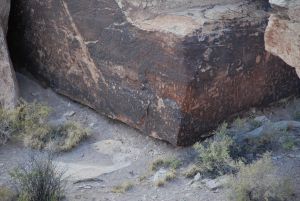A house on a cliff and a hole in the ground
 As
our car got the idea the day before, that it needed
its oil changed,
we
changed our plans and chose to go to the nearest
Avis Office.
Our navigation system told us that this was in
Flagstaff. We
therefore decided to go to Flagstaff before heading to the end goal of this
day drive, Holbrook.
As
our car got the idea the day before, that it needed
its oil changed,
we
changed our plans and chose to go to the nearest
Avis Office.
Our navigation system told us that this was in
Flagstaff. We
therefore decided to go to Flagstaff before heading to the end goal of this
day drive, Holbrook.
We left Payson heading northwest along a very narrow
road.
The road led through the Mazatzal Mountains and
through towns with botanical names like Strawberry
and Pine.
After 60 miles of small mountain roads, where we
rarely drove faster than 40 miles per hour, we
reached the Interstate to Flagstaff near the town of
Camp Verde.
Instead of going dirtectly to the Interstate (I-17), we decided however that we would visit
Montezuma Castle National Monument, which was just
north of town.
Montezuma Castle is an area where there are some
very well preserved, cliff dwellings, that is,
houses that is built up on the cliff wall.
Montezuma Castle was built by the Sinagua people
around the year 700, and the place was abandoned
again 725 years later.
The buildings have housed around 50 inhabitants.
When the white man came to the area around 1860, they thought that the
buildings were built by the Aztecs and therefore
named the place after Aztec emperor Montezuma.
It was very exciting to walk around the area, and
see the buildings, but also to see the nature
around the site.
Unfortunately it was very hot, and there was not
much shade as the sun shone from a cloudless sky, so
even with a hat on, it quickly became too much and
we had to get our car checked, so
 we
continued on to the highway and thence to
Flagstaff. At the Avis Office we were told that
the car's computer was set incorrectly, and that we
didn't have
too change oil for the next 2,500 miles.
Thus reassured, we could then continue our trip.
we
continued on to the highway and thence to
Flagstaff. At the Avis Office we were told that
the car's computer was set incorrectly, and that we
didn't have
too change oil for the next 2,500 miles.
Thus reassured, we could then continue our trip.
Our next stop was at "Meteor Crater", about 40-45
miles east of Flagstaff.
Here we left Interstate 40 and drove around 6 miles
south to the crater.
The crater, located at an altitude of 5,700 feet,
was created by a meteor 50,000 years ago.
A nickel-iron meteor about 160 feet in diameter and
weighing about 300,000 tons struck the earth with a
speed of approximately 28,000 miles per hour and
made a hole, which today is about. 0.7 miles
in diameter and 570 feet deep.
A crater rim rises about 150 feet
above the surrounding area.
On site, there was a museum that told of meteor
impacts in general and this one in particular. After a
short visit to the museum,
we walked to the rim and looked at the impressive crater.
It was a nice hole in the ground, and it is known as
the best preserved meteor crater in the world.
When
we got tired of looking at and into the hole, we
went back to the the museum.
While we walked around here it was announced that a
thunderstorm was approaching, and the next guided
tour would be canceled, and that those who
already were on a guided tour would be called back.
It's not the smartest thing to walk around on
top of a "mountain" on an otherwise perfectly flat
plateau during a thunderstorm.
Tim and I chose to go on and leave the place instead of waiting for the storm
to come.
 We
continued to today's goal, Holbrook and found a
hotel before we went to today's final destination,
Petrified Forest National Park.
Here we could use the
year pass that we had bought in Death Valley.
At this time we had already visited national parks
for $ 50, so it was almost recouped. And we still
hadn't
visited the Grand Canyon, Arches, Yellowstone, and maybe more parks.
We
continued to today's goal, Holbrook and found a
hotel before we went to today's final destination,
Petrified Forest National Park.
Here we could use the
year pass that we had bought in Death Valley.
At this time we had already visited national parks
for $ 50, so it was almost recouped. And we still
hadn't
visited the Grand Canyon, Arches, Yellowstone, and maybe more parks.
Petrified Forest National Park as the name suggests
is best known for its many fossilized trees found
mainly in the southern part of the park.
We started by visiting the Visitor Center and from
there we went for a walk among the petrified trees
along a path from the Center.
After the walking tour we drove the route that is
made through the park.
Here we stopped in many places, partly to see
petrified trees, partly to look at the stunning
views, there were many places and we saw both
petroglyphs (rock paintings) and ancient ruins from
the "Ancestral Pueblos" people who had
lived in the area earlier.
The northern part of the park includes a portion of
the Painted Desert, and here it is especially the
colored rocks, which makes the area interesting, so
here we also made some stops.
After driving around the national park we left the
park by the north exit and drove back to the hotel in
Holbrook.